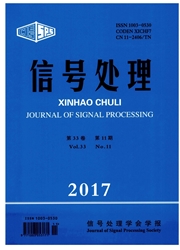

 中文摘要:
中文摘要:
针对现有超宽带穿墙雷达稀疏成像算法大多只采用点目标稀疏基表示模型和稀疏优化的正则化参数不能被自适应调整以及目标位置不在划分网格上带来虚假像的问题,该文提出一种基于贝叶斯证据框架的自适应稀疏成像方法。该方法首先利用组合字典独立稀疏表示场景中的点目标和扩展目标,然后在建立的偏离网格稀疏表示模型的基础上分层最大化各参数的似然函数,用第1层推理结合共轭梯度算法估计组合字典的各稀疏表示系数,用第2层推理估计正则化参数和目标的偏离网格量,最终通过迭代优化参数的设置得到问题的求解。仿真和实验结果表明,该方法不仅同时自适应增强穿墙场景中的点目标和扩展目标,还消除了偏离网格目标引起的虚假像。
 英文摘要:
英文摘要:
The existing algorithms of ultra-wideband through-the-wall radar sparse imaging mostly adopt point target model. Also the regularization parameter of sparse optimization can not be adjusted adaptively, and the ghost imaging can be produced if the targets are not positioned at the pre-discretized grid location. To deal with the above issues, an adaptive sparse imaging algorithm based on Bayesian evidence framework is proposed, which represents sparsely the scene with the point targets and the extended targets by combination of appropriate dictionaries, and maximizes hierarchically the likelihood function of all parameters as well. The first-level inference of the Bayesian, combined with conjugate gradient algorithm, is adopted to estimate the sparse representation coefficients of the combined dictionaries. The second-level inference of the Bayesian is adopted to estimate the regularization parameter as well as the targets' off-grid shifts. Therefore, the problem can be solved through iterative optimizating the parameter setting. The simulation and experimental results show that the proposed method can not only adaptively enhance the characteristics of both the point targets and the extended targets, but also mitigate ghosts caused by off-grid targets.
 同期刊论文项目
同期刊论文项目
 同项目期刊论文
同项目期刊论文
 期刊信息
期刊信息
